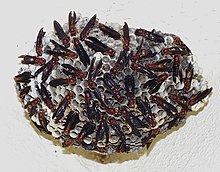Polistes annularis
[6] Unlike other wasps, P. annularis is relatively robust in winter conditions, and has also been observed to store honey in advance of hibernation.
The coloration of P. annularis typically includes a ferruginous (rust-red) head and thorax and a mostly black abdomen with a single, prominent yellow ring and the end of the first segment.
Similarly colored members of the subgenus Fuscopolistes, including P. metricus and darker forms of P. fuscatus, can readily be separated by the lack of contrasting orange antennal tips and the wider first metasomal segment.
[12] While many other North American Polistes species show sexual dimorphism in coloration, P. annularis and P. erythrocephalus rather uniquely do not.
[12] In the genus Polistes, the lateral mandibular groove is smaller in size than in other genera of social wasps.
[17] P. annularis is found throughout the eastern United States from New York to Florida, west to a line from South Dakota to Texas.
These tend to be built on the underside of overhangs that block exposure to sunlight for most of the day, such as rocky cliffs, in close proximity to bodies of water, primarily riversides.
[3][4] Meanwhile, the others construct the nest, from plant fibers, combined with oral secretions, to make a papery pulp that is formed into cells.
[19] The nest is attached to an overhang by a stalk-like pedicel, composed of oral secretions including proteins rich in glycine, proline, alanine, and serine, common components of the silks of other insects.
Although the probability is very low, a worker herself can eventually mate and assume the role of queen in the event that all foundresses of the nest die or leave permanently.
[3][4] Beginning during early to mid autumn as the temperature drops below about 5 °C and the workers die off, reproductive females prepare for winter by collecting and storing nectar in a highly concentrated form within open cells of the natal nest that eventually becomes a sort of honey.
By the winter, these reproductive females abandon the nest to hibernate, residing in shelters known as hibernacula, which include cracks within cliff walls.
Males, which often higher levels of glucose, fructose, and trehalose than foundresses, are able to continue mating into autumn or winter.
In the following spring, foundresses are retain association with their nestmates from the natal nest of the previous autumn and begin the colony cycle anew.
Additionally, if resources decrease, as during a drought, brood rearing ends sooner than in more prosperous years, and females choose to become gynes as opposed to workers.
Through the course of the colony cycle, the number of mated workers increases along with the queen's pronounced shows of dominance over the nest.
[3][4] P. annularis hunts mostly in wooded areas and preys primarily on caterpillars from a large number of lepidopteran families, including the Arctiidae, Saturniidae, Geometridae, Limacodidae, Lymantriidae, Notodontidae, Nymphalidae, Sphingidae, Erebidae, Noctuidae, Amphisbatidae, and Elachistidae.
Due to the dominance hierarchy, the reproductive foundress leaves the nest as little as possible, with foraging being done primarily by non-reproductive, worker wasps on her behalf.
[23] P. annularis is a primitively eusocial wasp, meaning that all individuals have the capacity for reproduction, regardless of social caste.
[24] As such, P. annularis demonstrates behavior typical of other polistine wasps, and has a dominance hierarchy, relatively small colony size compared to yellowjacket species, and a female-biased sex ratio.
[25]| Dominant females chew on or attach other colony members to demonstrate power, and this higher caste has a propensity for "tail-wagging" and checking cells as compared to the lower ranked workers, similar to behavior in Polistes dominula.
[26][27] A female on the nest will engage the arrival of a wasp from another colony with her antennae, and the clash may last for several minutes and even escalate into grappling.
[31] Group nesting through associations is especially prevalent and varied in P. annularis, with an arithmetic mean of between 3.82 and 4.93 and a full range from one to 28.
[33] Selective pressure tends to eliminate any additional foundresses once workers emerge due to multiple factors.
However, unlike other polistine wasps, more severe consequences occur for P. annularis after worker emergence, despite this change in behavior.
[36] In contrast to allied species, P. annularis have a lesser to absent ability to identify their relatedness to other workers to improve inclusive fitness.
[37] However, P. annularis do possess cuticular hydrocarbons on the surface of their bodies that may serve as social recognition factors.
For example, the related P. exclamans, which shares much of its eastern range with P. annularis and has a comparable relatedness between sisters of 0.39, may be a valid proxy in determining the sex allocation patterns of P.
These attacks routinely occur and increase over several weeks, during which nest construction and oviposition come to a stop, until certain wasps remit to leave room for a new queen.
[45] Birds often try to knock nests of P. annularis off of their overhanging, and colonies that hang low toward the ground can be attacked and eaten by raccoons.


